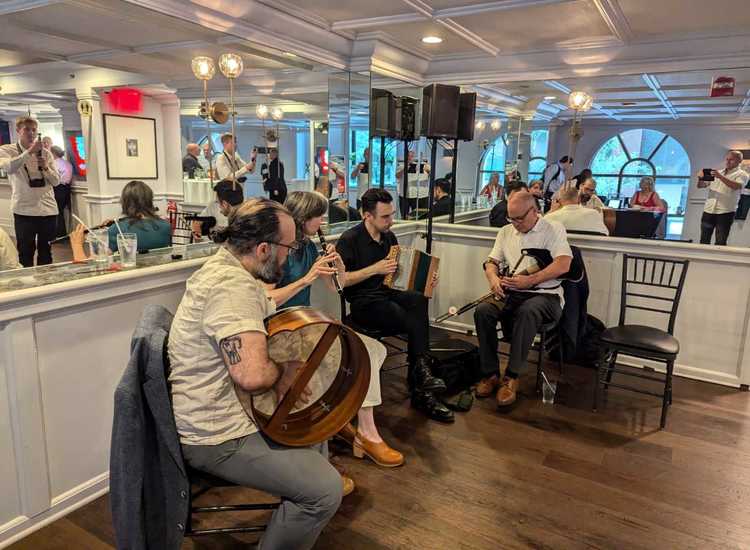The building at 326 Spring St., home to the Ear Inn, dates to 1817 and has had a tavern on the premises for almost of all of its 200-year history.
PHOTO BY PETER MCDERMOTT
By Michael Gray
Two New York City institutions join forces on Saturday for a big birthday, and a cause well worth supporting. Local charity God's Love We Deliver and the Ear Inn will celebrate a remarkable milestone in that tavern's history, and raise money to feed the charity's downtown clientele for a year.
GLWD has been serving meals for more than three decades to New York City residents housebound by illness. From a modest start delivering 50 meals a day by bicycle from the kitchen of the West Park Presbyterian Church on the Upper West Side, the organization reached a staggering total of 20 million meals served in September of this year. They have upgraded to a purpose-built Soho HQ with state-of-the-art kitchens, and now distribute meals to those in need across the city's five boroughs, Westchester and New Jersey.
On Nov. 11, the charity will team up with their Spring Street neighbors, County Cavan-born Martin Sheridan and Rip Hayman of the Ear Inn, to celebrate the bicentennial of that popular bar’s building and to raise funds to finance the supply and delivery of 35,000 meals to downtown residents for a full year. The target sum to meet that financial obligation is $350,000, and the organizers intend to raise it via charitable donations from corporations and individuals, and from a silent auction at the Ear's upstairs lounge of artwork donated by notable New York City artists.
The all-day event will be a family-friendly block party, with Spring Street closed to traffic, and live bands performing onstage throughout the day. Performers will include Dixieland jazz band the The Ear-Regulars, John Gill and The Dimestore Romeos, and Mulebone. The Ear Inn's Gary Lawler promises sporting activity for the kids as well, with guest appearances by soccer stars arranged by Downtown United Soccer Club.
The Ear Inn building is listed on the National Register of Historic Places, and is a New York City Landmark - one of the first buildings accorded that status when NYC Landmarks Preservation Commission was founded in 1965. A Federal-style brick building erected in 1817, its original owner was James Brown, an African-American aide to George Washington in the Revolutionary War, who ran a tobacco store at ground level at 326 Spring St., and lived upstairs.
It's an article of faith among Ear Inn regulars that Brown was with Washington when he crossed the Delaware on Christmas night in 1776 to launch a surprise attack on the Hessian mercenary forces encamped on the New Jersey side of the river. This belief is reinforced by the inclusion of an African-American oarsman, in a jaunty fedora hat, at the front of Washington's boat in Emanuel Gottlieb Leutze's celebrated painting of that Delaware crossing, copies of which hang in the Metropolitan Museum, the White House, and, of course, the Ear Inn. No matter that the artwork was painted in Dusseldorf 75 years after the event depicted - in the absence of factual evidence, the legend of the bar's association with the first U.S. president is much preferred.
After Brown's ownership of the building ended, 326 Spring St. became a tavern and was recorded as such as early as 1835, making it one of the oldest surviving bars in the city. Thomas Cloke, an immigrant from Ireland, took over in 1890, distilling whiskey in the cellar, and brewing beer in the backyard. Cloke sold on in 1919, wisely gauging which way the winds of temperance were blowing, just before the 18th Amendment to the U.S. Constitution outlawed the sale of alcohol across the land. The premises became a restaurant at the front and a speakeasy at the rear during Prohibition, and was known for decades as the Green Door. Steady trade from stevedores and factory workers kept the bar in business until the 1960s, by which time manufacturing and shipping had declined on the West Side, leaving west Soho in a state of near-dereliction. The bar's fortunes revived in the late 1970s when Hayman and Sheridan took over the building and the restaurant to make it the Ear Inn as we now know it (its name came from the clever trick of painting black the right side of the “B” on its Landmarked red neon “BAR” sign outside). A solid menu of burgers, Irish fare and draft beers, served by a mostly Irish staff, and a clientele of UPS workers, journalists and local eminences over the years give the Ear an enduring and convivial ambiance two centuries on that is extraordinary in a city that changes beyond recognition every couple of decades. Join in the celebrations, enter a piece of history, and support a good cause this Saturday, rain or shine, starting at noon.









